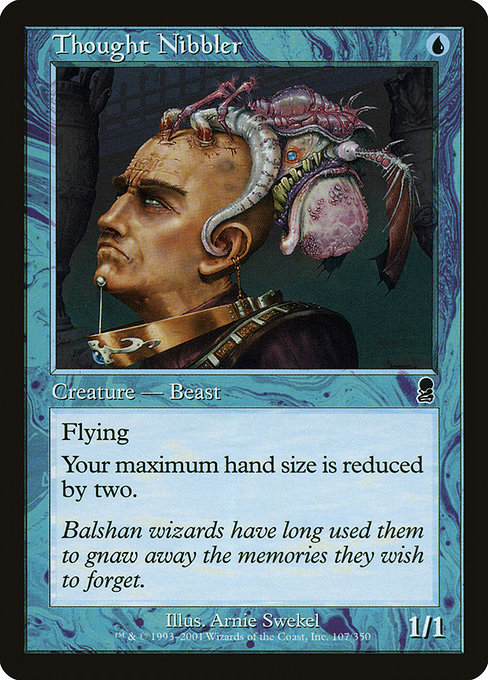
Image courtesy of Scryfall.com
Tracking long-term value for older sets
In the evergreen dialogue of Magic: The Gathering, the conversation about value isn’t just about the price tag on a card. It’s about the stories behind the cards, the arc of a set’s printing run, and how nostalgia intertwines with limited supply to create a durable, if patient, market. For longtime collectors and strategic players alike, older sets—like Odyssey, released in the turn of the millennium—offer a particularly rich lens. They’re not just about power curves or modern archetypes; they’re about the slow-blooming value that comes from rarity, art, and the enduring appeal of “what if” moments from MTG’s early 2000s era 🧙♂️🎨. This is where a card like Thought Nibbler serves as a charming case study: a modest common that whispers about long-run collectibility even as it flaps its wings on the battlefield.
A closer look at Thought Nibbler
Thought Nibbler is a blue (U) creature from the Odyssey set, a one-mana flier that checks in at 1/1. On the surface, that makes it one of the more humble flyers in the early days of evergreen blue. Yet its text—“Flying; Your maximum hand size is reduced by two.”—turns the card into a delightful little paradox: speed and evasion at the cost of hand discipline. The flavor text—“Balshan wizards have long used them to gnaw away the memories they wish to forget.”—adds a bite of wit that resonates with collectors who love era-specific lore and artful storytelling. This combination—affordable entry point, distinctive art by Arnie Swekel, and a memorable mechanical oddity—helps explain why Odyssey-era blues still catch the eye of vintage-minded players and graders 🧙♂️💎.
From a design perspective, Thought Nibbler embodies a time when Magic experimented with risk-reward trade-offs in the simplest possible package: a single blue mana for a 1/1 flier that imposes a resource tax. It’s not a marquee standout in terms of raw power, but it’s emblematic of the Odyssey line’s philosophy: flavor and curiosity as much as function. The card exists as a common in both foil and non-foil forms, which means it tends to form the backbone of growing-price catalysts for a subset of enthusiasts—the “show your first Odyssey card” crowd, the art fans, and those who chase interesting forecasts for long-tail sets 🔥🎲.
Long-term value: what actually moves the needle
Keeping an eye on long-term value for older sets requires a mix of practical scoring and a dash of market psychology. A few guiding principles apply nicely to Thought Nibbler and its peers:
- Rarity and print history matters: Commons like Thought Nibbler are abundant in the moment, but the allure grows when you add foil variants, border treatments, or misprints that collectors chase years later. Odyssey’s art, the card’s year, and the era’s collectibility all contribute to a slow appreciation curve.
- Foil premium versus non-foil baseline: The data for Thought Nibbler shows non-foil around a few tenths of a dollar, with foil edging higher. That foil premium often acts as a lever for long-term demand, especially among collectors who favor display-grade pieces or those who want a complete foil set from an era.
- Condition and grading: A near-mint Truth is worth more than a well-loved copy. For older sets, a well-preserved Thought Nibbler can outpace a higher-run, heavily played example because it’s part of a growing narrative—an Odyssey run, the art, and the nostalgia that accompanies a trip back to turn-of-the-century MTG.
- Reprint risk and rotation dynamics: Odyssey isn’t currently in print as a core reprint driver, which means cards from that era are less exposed to near-term price shocks due to new printings. The real pressure and opportunity come from the secondary market and the broader collector interest in vintage blue creatures with quirky downsides 🧭.
Strategies for players and collectors
For players, Thought Nibbler isn’t a modern meta anchor, but it shines as a reminder of how far MTG has come in design space. For collectors, it’s a features-and-flavor coin worth stamping into your portfolio. Here are practical moves to consider as you map out long-term value for older sets:
- Target condition-first purchases: Near-mint foils tend to hold up better than heavily-played copies in the long run, especially for a card that’s as iconic for its era as Thought Nibbler.
- Balance pricepoints: While it’s tempting to go deep on a glossy foil, a systematic approach—mixing a few chosen foils with solid non-foils—often yields a healthier, more liquid collection over time.
- Appreciate the art and lore: Odyssey-era cards are as much artwork as playables. The Swekel illustration and flavor text create a narrative hook that is increasingly valued by collectors who want “stories” packaged with their cards 🖼️.
- Preserve your cards safely: Long-term care is essential. Proper storage protects a card’s value far beyond the next reprint cycle, and a rugged phone case—like the Shockproof Phone Case shown below—can be part of a travel-friendly strategy for the collector on the go 🔒.
As you chart the arc of vintage value, it becomes clear that older sets thrive on a combination of sentiment, scarcity, and the joy of discovery. Thought Nibbler is a small, charming piece of that mosaic—a reminder that value in MTG’s older corners isn’t always about power, but about the story you carry with you when you play, collect, and reminisce 🎨⚔️.
Speaking of carrying and safeguarding—whether you’re flipping through a binder full of Odyssey cards or prepping for a weekend vintage event, a sturdy, protective case is a practical companion. Shop a durable option that complements your collection—the Shockproof Phone Case with a sturdy TPU/Polycarbonate shell. Shockproof Phone Case — Durable TPU/Polycarbonate Shell 🧳💎